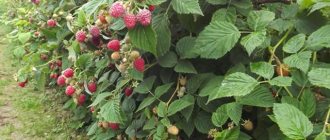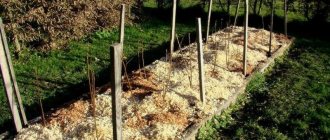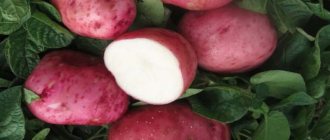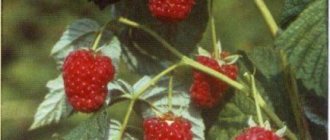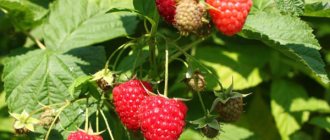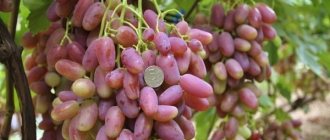Raspberry Glen Ample is one of the imported standard varieties, known for the strength and height of the stems. Among gardeners, such varieties are often called standard varieties. Let's find out why this overseas variety is interesting and whether it can be grown in our climate.
raspberry variety "Glen Ample"
The Glen Ample variety is classified as a raspberry of universal use.
The taste rating for Glen Ample raspberries reaches 9 points on a ten-point scale
Description of Glen Ample raspberries
The Glen Ample hybrid was bred by Scottish breeders in 1996. It was obtained by crossing two other foreign varieties - Meeker and Glen Prosen. The variety is popular in Europe, especially in the UK, where rainy and cloudy summers make it difficult to grow ordinary raspberries.
Features of the variety:
- Fruiting is not remontant. Fruits abundantly and regularly.
- It is classified as a variety with medium ripening periods. In a number of regions - with shorter summers, it is classified as mid-late.
- The variety is universal - it grows in open ground and under cover. Good for amateur and commercial cultivation. Mechanical harvesting of berries is possible.
Shoots and bushes
The main feature of the variety is its tall stems. The bushes are erect, usually their height is about 2 m. With good care and hot summers, the plant grows up to 3.5 m in height.
Other features of the bushes:
- The base of the bush is represented by one central shoot, from which 20-30 side (lateral) branches branch.
- Each lateral shoot produces about 20 berries. There is a large load on the bush - it needs to be tied to trellises.
- The root system is well developed.
- In the first year of life, the central stem has a green surface; in the second year, having become woody, it acquires a brownish-red hue. Often the brown stems are covered with a whitish coating.
- The leaves are located alternately on the shoots, they are dark green in color, and whitish on the inside. The leaves are slightly wrinkled and covered with white hairs.
- The shoots have a smooth surface; there are almost no thorns on the middle and lateral shoots.
- The branches of the bushes are spreading. The plant reaches 2 m in width, so there should be enough space between the bushes.
- The flowers are white, large, reaching 2.2 cm in diameter.
- The bushes produce a lot of root shoots - this simplifies the propagation of the variety.
Berries
Description of fruits:
- The berries are large. Their weight ranges from 2 to 10 g.
- The aroma is rich, raspberry.
- Color – bright red.
- The pulp is juicy.
- Sweet to taste. You can feel the sourness if the berries are a little unripe.
- Taste rating: 9 points out of 10.
- The berries have a regular conical shape.
- Once ripe, the berries do not immediately fall off. Moreover, having ripened, they retain their presentation, being on the branches for 2-3 days.
An overview of Glen Ample raspberries is presented by the gardener in the video below:
Harvesting and transportation
Ripening in Glen Ample begins in July and lasts about a month. Depending on weather conditions, these dates may vary. The ripeness of berries is determined by their color. The light and bright red color indicates that the berry is not yet ripe, but in this form it is already edible. If a gardener wants to achieve a more sour taste, it is recommended to harvest in this form. Fully ripe berries acquire a dark crimson color.
Here are some tips on how to harvest raspberries:
- Collection should be carried out with gloves;
- It is better to use boxes or baskets as containers, but in no case bags;
- It is better to collect in sunny weather without precipitation;
- Raspberries should be folded in 4–6 rows;
- It is not recommended to keep the collected berries in the sun; they should be delivered to a shaded area as soon as possible.
Did you know? Eating fresh raspberries will help get rid of a hangover thanks to the fruit acids they contain.
Thanks to its thick skin, Glen Ample raspberries tolerate transportation well, which allows them to be successfully used for commercial purposes. It is recommended to sell or consume freshly picked raspberries as soon as possible, since at a temperature of +20°C they can only remain fresh for 8 hours.
The shelf life can be extended by storing in the refrigerator or completely freezing.
The new Scottish variety Glen Ample is still rarely found in Russian gardens, but the situation is gradually changing. It is not for nothing that it captivated European gardeners with its merits - it is easy to grow both in a small private garden and on hectares of industrial area. Follow the simple rules of planting and care, and soon raspberries will delight you with a rich harvest.
Pros and cons of the variety
Glen Ample raspberries are considered very promising. Among its advantages, amateur gardeners and specialists note:
- ability to withstand low temperatures and lack of moisture for a long time;
- good preservation of berries - the variety is convenient for commercial purposes;
- high taste characteristics of berries;
- standard agricultural technology - nothing special is required for cultivation;
- thornless - makes it easier to pick berries;
- large fruit;
- high immunity to diseases and pests;
- low cost of seedlings.
The variety has no serious disadvantages; rather, it has features that are useful to know about in advance:
- the size, taste and structure of the berries depend on the composition of the soil - the amount of phosphorus and potassium in it;
- average disease resistance;
- The size of the bushes makes it difficult to pick berries.
History of variety selection
Glen Ample was bred in Scotland. To create a hybrid raspberry variety, scientists from the James Hutton Institute of Plant Sciences in Dundee took two mother varieties - Meeker and Glen Prosen. The British variety Glen Prosen imparted hardiness and thornlessness to the raspberry tree Glen Ample, and the South American Meeker endowed it with high yield and vigor. There are no Glen Ampl raspberries in the Russian Federation register, but this does not prevent the standard hybrid from gaining popularity among farmers or summer residents.
Productivity and fruiting
The variety in question is characterized by consistently high yields. Features of fruiting:
- The berries ripen along the entire length of the stem.
- One shoot yields 1.2-1.7 kg, 4-6 kg are collected from one bush, and 22-30 tons from 1 hectare.
- In the southern regions of the Russian Federation, berry picking begins in mid-June, in the central regions - in July.
- The duration of fruiting is one month.
To get a good harvest, the plant requires formation through proper pruning. We recommend reading the article on how to properly prune raspberries in the fall.
Sustainability
The variety is unpretentious and hardy, it withstands temperature changes and adapts well to various climatic conditions. Agrotechnical features of Glen Ampl:
- Frost resistance. The variety is frost-resistant. The bushes tolerate frosts of minus 30-35°C without damage. But in regions with harsh winters there is no need to take risks - plantings should be insulated in case of a snowless winter. Raspberry stems are bent, tied or braided in a horizontal position, and fixed. Spruce branches are laid on top of the shoots.
- Drought resistance. The variety tolerates short-term lack of watering well.
- Resistance to pests and infections. The variety is not afraid of raspberry aphids, as well as most berry diseases. May suffer from gray rot and rust. The variety is also susceptible to the dwarf virus.
The latest varieties of non-repairing raspberries from Switzerland
Prospera
The ripening period is mid-early. The stems are quite tall (up to 2 m), flexible, with incredibly abundant ovaries, so they need to be tied to a strong trellis. The berries are soft, medium-sized, raspberry-colored, oval or round with a slight taper towards the tip.
More on the topic: Features of Earlie Cumberland black raspberries
Advantages:
- very high fruiting potential;
- the berries are stored in the refrigerator for up to 5 days without loss of commercial quality;
- really sweet taste.
Fruatfree (synonym – TulaMagic)
Ripening dates are mid-early. An average number of replacement shoots is formed. The stems are tall (up to 2 m), slightly spiny, with a large number of fruit buds. Laterals are long and strong.
The berries are deep red, glossy, elastic, and easily removed from the fruit. Weight 5 – 7 g. Shape round or heart-shaped, with a slight slope to a cone. The variety tends to be remontant.
Advantages:
- longevity of the plantation, long-term yield of the crop;
- strong root system, with active development on any soil (even heavy);
- high resistance to fungal diseases of the stem (including didimella) and root rot;
- sweet taste of the fruit.
Flaws:
- problematic winter hardiness;
- increased fragility of stems when bent;
- the berry is not very transportable, rather soft, susceptible to gray rot.
Landing rules
The variety, having excellent economic characteristics, produces large yields in most climatic zones. Knowing the nuances of Glen Ample agricultural technology, we achieve the maximum possible from the variety.
Soil requirements
Glen Ample will grow on any soil, but only fertile soils can produce large yields. Special soil requirements:
- The best option is loamy soils.
- Soils should be light and loose, well conductive to air. Peat and sand are added to heavy soils.
- When planting, make a drainage layer.
- You cannot plant seedlings in lowlands, swampy and damp areas.
- The soil must contain a sufficient amount of humus. Fertilizers applied during planting of seedlings are sufficient for two years of growth. Then the plants should be fed regularly.
Lighting
The Glen Ample variety, like any raspberry, prefers well-lit areas. But too much sun can damage plants - they can “burn.” The best option is an area that is well lit in the first half of the day.
In the afternoon, plantings can be in shade or partial shade. The bushes are planted so that the sun evenly illuminates all their parts. The recommended distance between bushes is 60 cm, no less. Between rows - 2.5-3 m.
From excessive sun, Glen Ample raspberries can not only “burn”, but also develop rust.
Preparation of land and planting material
The procedure for preparing a site for planting:
- Dig up the soil, removing weeds.
- When digging, add organic matter - 2-3 buckets of humus or compost per 1 square meter. m, as well as superphosphate - 200-400 g, and potassium sulfate - 100-200 g per 1 sq. m.
- Prepare a hole for each bush. Approximate diameter - 60 cm, depth - from 25 cm. You can plant bushes along the fence.
The best time for planting is spring, when the risk of return frosts has passed and the soil has warmed up sufficiently. Raspberries can also be planted in the fall. The exact planting dates depend on the region. Gardeners believe that planting raspberries in autumn is more effective. Seedlings are planted a month and a half before frost so that they have time to take root well.
You can learn how to plant raspberries in the spring from this article.
Planting material is purchased in specialized nurseries or prepared in the fall. Planting material is stored until spring in a cool place - for example, in a cellar.
When buying seedlings, inspect them carefully. The roots should be strong, elastic, not dry. There should be 3 buds near the base of the seedling. The optimal height is 20 cm, diameter is 1 cm.
It is not recommended to buy seedlings with roots wrapped in polyethylene, especially if there is a long transportation ahead.
Reproduction methods
You can expand the planting of the variety in one of the following ways:
- Cuttings. Select the best shoots, cut raspberry cuttings 10-12 cm long. Place in damp sand in the basement or on the bottom shelf of the refrigerator. Plant in the ground in spring.
- Root propagation. Make grooves in the nutrient soil into which to place parts of the raspberry root system. Water, cover with soil. When planting in autumn, make an earthen mound for insulation.
- Seeds. A complex and time-consuming method.
Gardeners use the first two, and experimenters use the third.
Planting schemes
Glen Ample is a powerful plant that reveals its potential if two conditions are met:
- Uniform sunlight from top to bottom.
- Staking the stems with minimal pruning of the tops.
Taking these requirements into account, a one-line landing looks more profitable.
Boarding order:
- With any planting method - bush or linear, single- or double-line, it is important to maintain the distance between rows at 2.5-3 m. Prepare holes for the seedlings:
- planting scheme for single-line planting - 3x0.3 m;
- with two-line - 3.5x0.5x0.3 m.
- Fill the holes one-third full with fertile soil mixed with fertilizers. Add a bucket of compost/humus, 400 g of wood ash and 50 g of potassium sulfate into each hole.
- Place the seedling in the hole so that the replacement bud is 2-3 cm below the soil level. Having spread the roots in different directions, cover them with fertile soil. Compact the soil with your hands.
- Make a narrow groove around the seedling and pour water into it. When the moisture is absorbed, sprinkle the hole with mulch - humus, straw, sawdust.
- Trim the seedlings to a height of 20-30 cm from ground level.
- If there is no rain for a couple of days after planting, water the young raspberries.
Caring for the Glen Ampl variety
Care procedure:
- Feeding. Bushes especially require a lot of organic matter and nitrogen - they are added in the spring. In summer, plantings are fed with complex fertilizers with potassium and microelements; in autumn, phosphorus-potassium fertilizers are applied.
- Watering. Abundant moisture is necessary in early spring, during budding and flowering. During the formation of ovaries - 2-3 waterings at intervals of a week. With a lack of moisture, the berries become small. Watering rate is 30-40 liters of water per bush.
- Loosening, weeding, mulching. During the planting season, the plantings are weeded a couple of times and the rows are loosened. To prevent the growth of weeds and preserve moisture, the soil is sprinkled with humus, peat, and straw.
- Tying. The shoots are very tall, so they must be tied to trellises - this is a key feature of the variety.
- Trimming. To facilitate fruit harvesting, tall shoots are double pruned. This method allows you to form a raspberry “tree” from each shoot. To do this, replacement shoots are cut to 1 m at the beginning of summer. In July, the lateral branches that have grown over the month are pinched off. This is how a one and a half meter shoot with branches is formed, each of which will bear berries next summer.
- Braiding. This method of care is also aimed at making berry picking easier. The tops of the stems are wrapped around the top wire on the trellis - it should be at a height of 1 m. Then all the fruit branches will be within comfortable reach.
- Spraying. In the spring, preventive spraying is carried out - against diseases with fungicides, against pests with insecticides.
- Preparing for winter. In regions with harsh winters, the shoots are tied, bent, and covered with agrofibre.
Wintering
The raspberry tree tolerates frost well, especially if it grows in a region where heavy snow cover forms in winter.
Preparing for winter:
- bend the stems to the ground;
- fix;
- wrap with spruce branches or straw.
Interesting! The British variety tolerates winters better in the Middle Zone rather than in the south. It is important for bushes that they are covered with snow. Therefore, gardeners in the southern regions do not leave such good reviews about the plant.
Also pay attention to the advice of experts: do not cover the bushes with film, this will not allow them to breathe. Snow provides excellent cover for Glen Ample. In most cases, it is completely sufficient for the well-being of the plant.
Diseases and pests
The immunity of the variety is quite high - experts gave it 8 points on a 10-point scale. Thickened plantings can provoke rust and powdery mildew.
Main diseases and pests of Raspberry Glen Ampl:
| Disease/pests | Symptoms/harm | How to fight? |
| Gray rot | The leaves and shoots are covered with a gray fluffy coating. | Spraying bushes and soil with HOM. For 10 liters – 40 g. This volume is enough for 10 sq. m. |
| Powdery mildew | Berries, growing points, shoots and leaves are covered with a light gray cobwebby coating. The fruits become unfit for consumption. | Plantings are sprayed with environmentally friendly biofungicides. Chemical preparations are also used - Topaz, Quadris and others. |
| Rust | Yellow-orange raised spots and gray cankers with a reddish border appear on the upper side of the leaves. The leaves dry out and the yield drops. | Spray with Bordeaux mixture and fungicides - Kuproxat, Polyram DF, etc. |
| Raspberry beetle | Beetle larvae deform flowers. Productivity is falling. | Spraying with Fufanon in spring. |
| Raspberry fly | The larvae chew out the stems and eat the leaves. | Spraying with Iskra - 2 weeks after treatment with Fufanon. |
You can see photos and descriptions of these and other diseases here.
Reviews of Glen Ample raspberries
★★★★★
Alexander E., Krasnodar region. I planted this imported variety with caution to see if it would like our conditions.
It turned out to be quite hardy and unpretentious. The main advantage is the absence of thorns. I’m also pleased with the yield; I get 4 kg of berries per 1 linear meter. I tie the bushes onto 2-meter trellises - this improves lighting and makes care easier. ★★★★★
Georgy Ts., Belgorod region. The variety has very tall stems, so it is impossible to grow it without trellises.
I noticed that the more sun falls on the berries, the larger and sweeter they grow. Therefore, I tie bushes of the same row onto two trellises at once. Hide
Add your review
Scottish raspberries Glen Ample grow and bear fruit well in our climate. This standard variety does not require special growing conditions; it has high yields, is hardy and unpretentious. The main thing is to take care of installing the trellis and tying its long stems correctly.
0
0
Copy link
